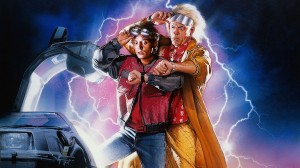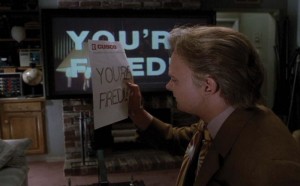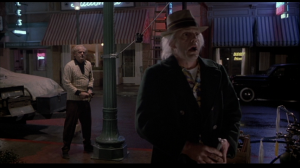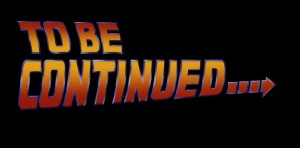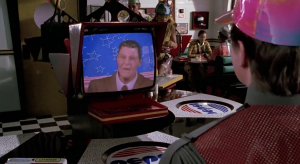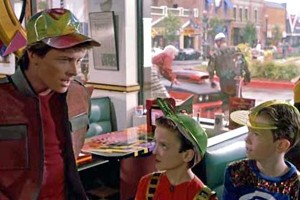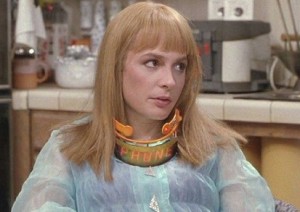100 Film Favorites – #22: Back to the Future Part II
(Robert Zemeckis, 1989)
“Roads? Where we’re going, we don’t need roads.”
Those words, spoken by all-time great “mad scientist” character “Doc” Emmet Brown, end 1985’s Back to the Future on a cliff-hanger. After Marty McFly’s time-trip to 1955 in the first film proved a success and ultimately resulted in a new and improved 1985, the teenaged McFly is sitting pretty. Marty receives the car of his dreams from his now-prosperous parents, and prepares to depart for “the lake” with his girlfriend, Jennifer Parker.
Suddenly, Doc, now wearing a bright yellow trenchcoat and a necktie made of transparent laminate, comes careening around the corner in the iconic Delorean time-machine. Doc explains that he has recently traveled 30 years into the future (to the distant year of 2015), and has made some modifications to the car (including the addition of a “Mr. Fusion” reactor which can convert bits of trash into nuclear energy). Doc tells Marty and Jennifer that they must go “back to the future” with him, as “something’s got to be done about your kids!” At Doc’s insistence they pile in, and he powers up another time machine add-on: a “hover conversion” which allows the car to fly. Adjusting his cool future-shades, Doc, Marty, and Jennifer blast forward to the year 2015, and the film comes to a dramatic close.
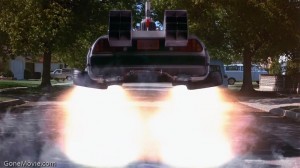
Back to the Future was originally conceived of as a single film rather than a trilogy. This is somewhat difficult to believe. The first film does end with a cliffhanger, so the filmmakers must have at least considered the making of sequels to be a possibility. Regardless, the massive success of the first movie (grossing more than $350 million on a budget of $19 million) dictated that sequels needed to be made, and Back to the Future Part II and Part III went into production simultaneously.
Part II begins by re-playing the final scene from the first film, after which the trio’s time-jump lands them in the year 2015, zooming through the sky among other flying-car traffic. Almost immediately, Doc incapacitates Jennifer with some kind of sleep ray, much to Marty’s surprise. Why exactly Doc invited Jennifer along if all he wanted to do was instantly knock her out is never explained. Indeed, Filmmakers Bob Gale and Robert Zemeckis have said that if they had known for certain they would be making a Back to the Future sequel, they never would have had Jennifer accompany Doc and Marty to the future in the first place. This is kind of a shame, and the character of Jennifer (even if she never had much character in the first place) is wasted in Part II, as she spends most of the film unconscious, due either to the influence of Doc’s sleep ray or the shock of encountering her future self. Her under-representation may be due in part to the fact that Jennifer’s original actress, Claudia Wells, was unable to return for the sequels and was re-cast, with Elizabeth Shue in the role for Parts II & III.
At any rate, Doc explains to Marty that in the “normal” 2015, Marty McFly, Jr. gets arrested after being bullied into assisting Griff Tannen and his gang with a robbery. Doc sends in Marty to impersonate his son and turn Griff down. Griff is miffed, and starts a tiff. Mirroring a scene from the original film, Marty grabs a futuristic “hoverboard” – a levitating skateboard without wheels – and takes off down the street, with Griff and his gang in pursuit, aboard hoverboards of their own. Actually, Griff goes one better and busts out a “Pit Bull,” a souped-up hoverboard capable of gliding over water. Before Griff can catch him, Marty swerves at the last second, and Griff goes sailing through the glass storefront of the complex which has built up around Hill Valley’s historic clock tower. The gang is apprehended, and Marty, Jr. is safe.
Meanwhile, Jennifer has been abandoned unconscious in an alleyway like a piece of trash. Passing cops identify her with a fingerprint scan and “return” her to her future home, where she eventually awakens to find the 47-year old Marty and Jennifer McFly coexisting in less than matrimonial bliss. Marty has lost his ability to play guitar, apparently due to an injury he sustained in a car crash in his youth. He now works as a salesman within a vaguely-defined corporation. When his co-worker “Needles” (Flea of the Red Hot Chili Peppers) approaches him with a shady business deal , Marty is wary, but enters into the bargain after Needles calls him “chicken.” Marty’s boss discovers his clandestine dealings almost instantaneously, and fires Marty.
Strolling the streets of 2015, “our” Marty comes upon an “old” sports almanac which holds the results of every major U.S. sporting event from 1950-2000. When he expresses a desire to take the book back to the past and use it for gambling, Doc chastises him. However, an elderly Biff Tannen, Griff’s grandfather and the antagonist of the first film, overhears Marty’s plan and puts the scheme into practice, absconding with the time machine and returning again before Doc or Marty notice. None the wiser, Doc and Marty swing by to pick up Jennifer (I’m not sure why; they don’t seem to care about her very much) and head “home” to 1985.
The time-traveling trio are shocked to find the Hill Valley of 1985 drastically different from how they had left it. The town is decrepit, polluted, and crime-ridden. Biff is the richest man in the region, and dwells in a skyscraper which also houses the official Biff Tannen Museum. He is married to Lorraine McFly, Marty’s mother, and murdered Marty’s father some time in the 70s. Doc proposes that this version of 1985 must have resulted from an earlier instance of time travel which caused the timeline to branch, or deviate from its original course. To find out when this “branching” occurred, Marty confronts Biff, and learns that he grew rich as a result of gambling using the information obtained in the future almanac. Biff reveals that he was visited as a teenager by the 2015 version of himself, who gave him the almanac and warned him to kill anyone who might come asking about the book.
Marty narrowly escapes, and he and Doc return to the night young Biff received the almanac: November 12th, 1955 – the night of the “Enchantment Under the Sea” dance, and the night on which Marty first went “back to the future” at the end of Part I. As they trail Biff, Doc and Marty must be cautious. The events of the first Back to the Future movie are unfolding around them, and they must avoid running into their past selves and/or interfering with the success of “past them’s” mission, lest they cause a whole pile of paradoxes. This allows us to see memorable scenes from the first film from entirely new angles (“present Marty” crawls along the catwalk overhead while “past Marty” plays “Johnny B. Goode” on stage; “present Doc” covertly advises “past Doc” on how best to set up the “weather experiment” intended to channel lightning into the time machine).
To make a long story marginally less long, Marty succeeds in getting the almanac away from Biff without disturbing the events of the original film. Marty destroys the book, “fixing” the branched timeline and restoring the “good” Hill Valley of 1985. All is hunky dory until the Dolorean, hovering above with Doc inside, is struck by lightning. In a fireball, the time machine blasts away to an unknown time period, taking Doc with it.
Almost simultaneously, a Western Union courier arrives, bearing a very old-looking letter addressed to Marty. “I’ve been instructed to deliver this to you…now,” he says, handing over the letter. It turns out to be from Doc. The latest time-jump stranded him in 1885, when Hill Valley was but a rustic western town. Since an AWOL time machine means Marty is stranded too, the 1980s Doc (now in the 1880s) advises Marty to seek the counsel of 1950s Doc, who should “know what to do.” 50s Doc, having just sent one Marty “back to the future,” is shocked at the sudden appearance of another. Doc faints in the street, and as the screen fades to black, we are presented with those three famous words:
If you can look past the screenwriters’ blatantly lazy “problem-solving” through simply abandoning Jennifer in the garbage, Back to the Future Part II is overall a very good time travel movie. The idea of forming and undoing “alternate timelines” through one’s actions is a compelling addition to the trilogy’s time travel rules, and the “dark” 1985 is well-realized and quite menacing. Additionally, having multiple iterations of Marty, Biff, Doc, and the Delorean all running around 1955 trying to avoid each other showcases in a fun way just how convoluted time travel can get.
My one major problem with the film is that I wish the characters had spent more time in the 2015 era. While it’s interesting to see “Part I” scenes from a new perspective, particularly to learn how such interwoven scenarios play out under the series’ “time travel rules,” I still feel mildly cheated: Spending a third of the movie simply re-living the previous film seems almost as lazy as the choice to dump Jennifer on the trash heap.
What we do get to see of the future, though, is awesome. The filmmakers strove to create a future which was neither utopian nor dystopian, but one in which life continues on pretty much as before, just with a new set of gadgets and fads. We learn that teens of 2015 Hill Valley turn their pockets inside out to look cool, and they wear self-lacing sneakers and self-drying jackets.
Business attire is revolutionized as well: businessmen wear themed pairs of two neckties at a time, side by side. The pair rocked by future Marty is especially impressive, with the rays of the Rising Sun spreading across two yellow ties. This is a trend I’m seriously considering starting. Hey, I’ve got two years to make it catch on!
The 2015 sequence is full of other interesting predictions, ranging from the pretty spot-on (Miami would get a Major League Baseball team; Flatscreen TVs with multiple picture-in-picture settings would be common) to the wildly inaccurate (there would be multiple fax machines in every room; 2015 would see the release of Jaws 19). This imagining of the future also includes two things I can’t believe haven’t been created yet: 1. The hoverboard (okay, they kind of exist, but they don’t look like the ones in the movie), and 2. The Cafe 80s. 50s-inspired diners were big by the 80s, so it makes sense that an 80s-inspired restaurant would do brisk business now, right? (Okay, I guess “BGR” is kind of that same idea, but it’s just not the same if your food isn’t served by Max Headroom, Michael Jackson, and Ronald Reagan).
Tidbits:
-Crispin Glover’s requested salary for the film was considered too high, and so the filmmakers simply replaced him with Jeffrey Weissman as George McFly. Weissman was typically shot only from the side or back, and wore makeup and facial prostheses which made him closely resemble Crispin Glover, to give the impression it was actually him in the role. Glover took issue with this, and filed suit against Universal, saying they did not own his image, and therefore could not appropriate it without his permission. The Screen Actors Guild subsequently introduced regulations which forbade this kind of unauthorized image use.
–Back to the Future Part II features the film debut of a young Elijah Wood. In the Cafe 80s scene, Wood appears as a boy who dismisses an 80s-era arcade game as “like a baby’s toy” because the player “has to use their hands.”
-The film also marks the first use of Industrial Light and Magic’s “Vistaglide” camera. Many of the film’s scenes feature a single actor playing multiple roles, or (because of the weirdness of time travel) simply standing in two places at once. In the past, this effect could only be accomplished with a static camera. The Vistaglide enabled filmmakers to shoot such scenes with a mobile camera for the first time.
-On that note, Marty McFly must have some seriously dominant genes. His children (both his son and daughter) look exactly like him (they’re both played by Michael J. Fox).
—
Brian Terrill is the host of television show Count Gauntly’s Horrors from the Public Domain. You can keep up with Brian’s 100 Film Favorites countdown here.


